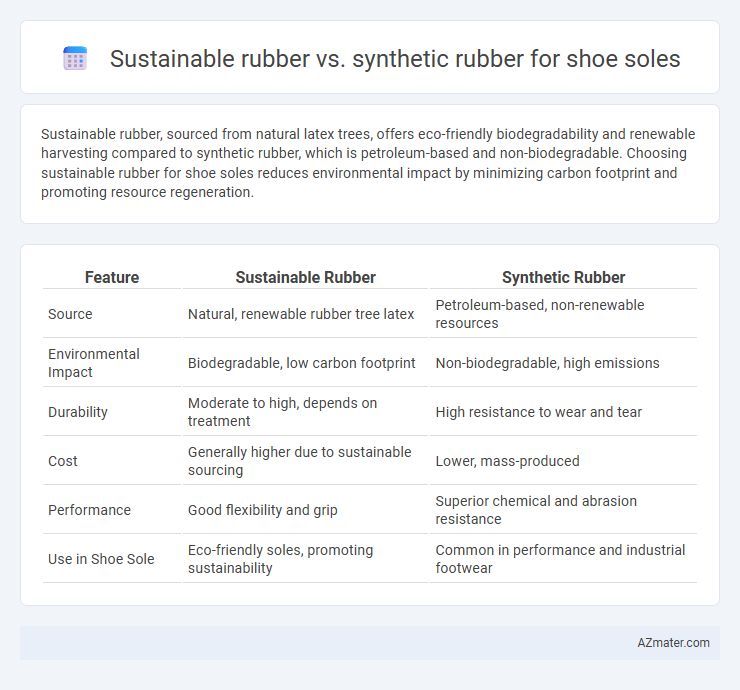Sustainable rubber, sourced from natural latex trees, offers eco-friendly biodegradability and renewable harvesting compared to synthetic rubber, which is petroleum-based and non-biodegradable. Choosing sustainable rubber for shoe soles reduces environmental impact by minimizing carbon footprint and promoting resource regeneration.
Table of Comparison
| Feature | Sustainable Rubber | Synthetic Rubber |
|---|---|---|
| Source | Natural, renewable rubber tree latex | Petroleum-based, non-renewable resources |
| Environmental Impact | Biodegradable, low carbon footprint | Non-biodegradable, high emissions |
| Durability | Moderate to high, depends on treatment | High resistance to wear and tear |
| Cost | Generally higher due to sustainable sourcing | Lower, mass-produced |
| Performance | Good flexibility and grip | Superior chemical and abrasion resistance |
| Use in Shoe Sole | Eco-friendly soles, promoting sustainability | Common in performance and industrial footwear |
Introduction to Rubber Types for Shoe Soles
Natural rubber, derived from the latex of Hevea brasiliensis trees, offers excellent elasticity, resilience, and biodegradability for shoe soles, making it a sustainable choice. Synthetic rubber, produced from petrochemical polymers such as styrene-butadiene and ethylene-propylene-diene monomers, provides enhanced durability, abrasion resistance, and weather stability. The choice between sustainable natural rubber and synthetic rubber involves balancing environmental impact, performance characteristics, and long-term wear resistance in footwear manufacturing.
What Is Sustainable Rubber?
Sustainable rubber is derived from natural sources such as rubber trees grown under environmentally responsible farming practices that prioritize biodiversity, soil health, and reduced chemical usage. This type of rubber offers a lower carbon footprint and enhanced biodegradability compared to synthetic rubber, which is petroleum-based and non-renewable. Shoe soles made from sustainable rubber provide durability and eco-friendliness, aligning with consumer demands for environmentally conscious footwear materials.
Overview of Synthetic Rubber
Synthetic rubber, primarily derived from petrochemical sources such as styrene-butadiene rubber (SBR) and nitrile butadiene rubber (NBR), offers superior durability, abrasion resistance, and cost-effectiveness for shoe sole manufacturing. Its consistent quality and excellent mechanical properties, including high tensile strength and elasticity, make it ideal for performance footwear in demanding environments. Despite environmental concerns related to its petroleum-based origins, ongoing innovations in bio-based synthetic rubber aim to reduce carbon footprint and enhance sustainability in production.
Environmental Impact: Sustainable Rubber
Sustainable rubber used in shoe soles significantly reduces environmental impact by promoting responsible harvesting from rubber trees, which supports biodiversity and prevents deforestation. It involves natural latex extraction methods that minimize chemical use and decrease carbon emissions compared to synthetic rubber derived from petroleum. This eco-friendly approach enhances biodegradability and reduces reliance on fossil fuels, aligning with sustainable manufacturing goals in footwear production.
Environmental Impact: Synthetic Rubber
Synthetic rubber, derived primarily from petrochemicals, has a significant environmental footprint due to its reliance on non-renewable fossil fuels and energy-intensive manufacturing processes. The production emits substantial greenhouse gases and generates pollutants that contribute to air and water contamination. Disposal challenges arise as synthetic rubber is non-biodegradable, leading to persistent waste in landfills and oceans, exacerbating environmental pollution.
Performance and Durability Comparison
Sustainable rubber, derived from natural latex, offers superior elasticity and breathability compared to synthetic rubber, enhancing comfort and wear resistance in shoe soles. Synthetic rubber, typically made from petrochemicals such as styrene-butadiene, provides higher abrasion resistance and better performance under extreme temperatures, contributing to prolonged outsole durability. The choice between sustainable and synthetic rubbers balances environmental benefits with specific performance metrics like tensile strength, hardness, and resistance to UV degradation for optimized shoe sole longevity.
Cost Analysis: Sustainable vs Synthetic Rubber
Sustainable rubber sourced from natural latex offers cost advantages due to renewable harvesting methods and lower environmental remediation expenses compared to synthetic rubber derived from petroleum-based polymers. While synthetic rubber provides consistent performance at lower raw material costs, fluctuating oil prices and increased regulatory fees can elevate long-term expenses. Lifecycle cost analysis shows sustainable rubber reduces disposal and carbon footprint costs, making it a competitive choice for eco-conscious shoe sole manufacturing.
Supply Chain and Sourcing Challenges
Sustainable rubber for shoe soles faces significant supply chain challenges due to limited plantation availability, longer growth cycles, and reliance on smallholder farmers, which complicates consistent quality and volume sourcing. Synthetic rubber, derived primarily from petrochemicals, benefits from a more stable and scalable supply chain but faces increasing scrutiny over environmental impact and raw material volatility linked to oil markets. Both materials require strategic sourcing approaches, with sustainable rubber demanding certification and traceability efforts, while synthetic rubber necessitates innovations to reduce carbon footprint and dependency on fossil fuels.
Consumer Preferences and Market Trends
Sustainable rubber, derived from natural sources like Hevea brasiliensis, appeals to eco-conscious consumers due to its biodegradability and reduced environmental impact compared to traditional synthetic rubber made from petroleum-based polymers such as styrene-butadiene rubber (SBR). Market trends indicate a rising demand for sustainable footwear, with brands prioritizing transparency in sourcing and lifecycle assessments, driving innovation in bio-based and reclaimed rubber materials for shoe soles. Consumer preference shifts toward durability combined with eco-friendly attributes position sustainable rubber as a competitive alternative, supported by increasing regulatory pressures and growth in green product certifications globally.
Future Prospects for Sustainable Footwear Materials
Sustainable rubber, derived from natural sources like Hevea brasiliensis, offers renewable and biodegradable advantages over petroleum-based synthetic rubber, aligning with the footwear industry's shift towards eco-friendly materials. Innovations in processing natural rubber enhance durability and elasticity, making it increasingly competitive for high-performance shoe soles. Future prospects emphasize scaling sustainable rubber production and integrating bio-based additives, promising reduced carbon footprints and improved lifecycle sustainability for footwear materials.

Infographic: Sustainable rubber vs Synthetic rubber for Shoe sole
 azmater.com
azmater.com